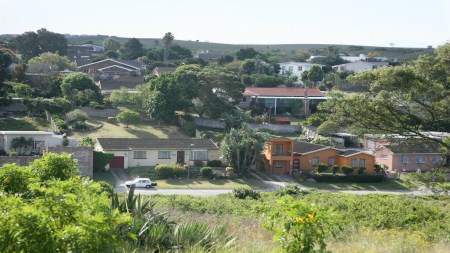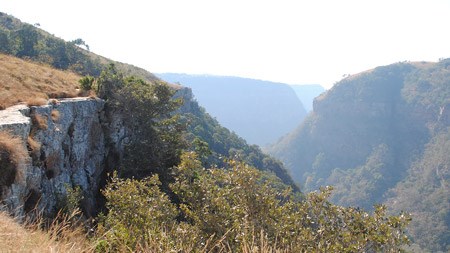South Africa is currently beset by a number of socio-economic challenges. Cons aside, there are still pockets of positivity and ingenuity to be found. One such example takes the form of Maboneng, a mixed use precinct which has taken root within the gritty boundaries of Johannesburg’s infamous inner city.
Once the uncontested domain of numerous ‘bad buildings’ and some of Johannesburg’s most unsavoury social elements, Johannesburg’s inner city has slowly but surely been undergoing a makeover over the past few years catalysed largely by a few forward thinking corporate companies, initiatives implemented by the Johannesburg Metropolitan Council and a few dynamic property developers.
Collectables are sold in a loft.
Of the various regeneration initiatives, Maboneng is arguably one of the most successful. The brainchild of property developer Jonathan Liebmann and acclaimed sustainable architect Enrico Daffonchio, Maboneng is being developed with a view to providing a safe, culturally diverse mixed-use precinct which encourages artistic collaborations.
A daring project which quite easily could have failed, Maboneng has gone from strength to strength since its inception in 2009. The precinct kicked off with the advent of Arts on Main, a unique blend of studio, commercial and retail spaces which occupy the husk of an early 1900’s bonded warehouse and the old DF Corlett construction offices on Main Street. William Kentridge, GoetheOnMain, Nitrox Projects, David Krut Publishing and Black Coffee are but a few of the names which fast became associated with this node.
Unexpected artwork on every corner.
Following the success of Arts on Main, Market on Main, an organically orientated food market was established. Every Sunday, entrepreneurial vendors set up shop to sell all manner of delectable nibbles to an eager public who keep coming back for more. A variety of locally designed clothes, shoes, fabrics and collectables are also sold in Arts on Main’s loft area.
Just outside Arts on Main’s primary space lies an appealing courtyard punctuated by olive and lemon trees. The courtyard restaurant, Canteen, provides tasty meals which can be enjoyed under the trees or at the restaurant’s trendy rooftop setting. Those in the mood for dessert can try one of the unique ice creams sold by the vendor who stakes out a spot under the trees over weekends. Flavours for sale include, amongst others, peanut butter and jelly, salted caramel, berry and hibiscus and dragon fruit.
A short walk from Arts on Main lies Revolution House which was built in the 1920’s to house a juice factory. In later years the building was hijacked and fell into disrepair. Today, the building has been given a new lease on life. It offers three floors of residential space segmented into double studios, penthouses and exclusive rooftop units. Private rooftop gardens, a ground floor retail section and indoor parking also feature. On the first floor, band rehearsal rooms, film studios and post production facilities have taken up residence.
While walking around the precinct, you’ll no doubt come across Uncle Merv’s, a diminutive street café which serves all natural smoothies, coffee, croissants, homemade muesli and sandwiches. The ‘Felix King’ smoothie (a combination of peanut butter, soy milk, banana, honey and dates) was a winner in my books. If you’re up for it, you can also rent a bicycle from the cafe.
Nothing about Maboneng is ordinary.
A mere stone throw from Uncle Merv’s is Main Street Life, Maboneng’s first mixed-use residential development. Converted from a 1970’s sports clothing factory, Main Street Life offers 194 well designed single, double and penthouse units alongside commercial space, workshops, exhibition and event venues including the Bioscope (an independent cinema) and POPart Theatre. Pata Pata restaurant, Chalkboard Café, Sorted Laundry and Got Ink Tattoos have carved themselves a niche on the ground floor while the 12 Decades Hotel, a bar and gym have taken up residence on the rooftop. Just next door to Main Street Life lies Fox Street Studios which accommodates yet more residential studios, restaurants, fashion and design stores and the precinct’s own community centre.
Main Street Life’s 12 Decades Hotel is a noteworthy feature in its own right. Unlike the stock standard, clinical rooms associated with many brand name hotel chains, the hotel offers an eclectic collection of rooms designed to reflect Johannesburg’s 12 decade long history. Lauren Wallet’s theatrically themed ‘Who is Herbert Dlomo?’ room for instance represents the Bantu theatre movement of the 1930’s. The ‘Perpetual Liberty’ room engages with the various stages of establishing and understanding a new democracy. Plans to upgrade and extend the hotel are in the pipeline.
Just around the corner from Main Street Life is another Maboneng outpost, The Main Change. Also developed from a 1970’s industrial factory, The Main Change houses a variety of office units including a co-working space for freelancers. Loin Cloth and Ashes, House of Baobab and the Blackanese sushi and wine bar occupy the ground floor of this establishment. For fantastic views overlooking the city, visit The Main Change’s Living Room, a beautiful rooftop health food café sprinkled with plants and cosy hammocks. Cocoon, a popular spa and yoga retreat is located just opposite the Living Room.
Maboneng is a work in progress and ambitious plans are afoot to convert a number of old buildings in the area (ten at the last count) into contemporary, multi-functional nodes. One project which is currently being sold off plan is Artisan Lofts, a collection of custom designed living spaces spread over a multi-storey building located adjacent to MOAD, Maboneng’s Museum of African Design. The units range in size from 70sqm’s to 200sqm’s and are priced at between R310 000 and R1, 9 million. In true Maboneng style, a ground floor retail section will also feature.
One of the aspects I appreciated most about the precinct is the fact that far from completely gutting the interiors and modernising the exteriors, a number of the original industrial elements have been incorporated into the current framework which lends the precinct a suitably historic feel. I was delighted by the artistic motifs which pop out from the most unexpected corners and revelled in the obvious encouragement of freedom of expression.
It’s quite obvious that Johannesburg desperately needed a precinct such as Maboneng. Getting there still means running the gauntlet of Joe Slovo Drive or Main Street but if you can get past this fact and make the journey you’ll quickly realise why Maboneng has generated the buzz it has. The fact that practically all of Maboneng’s nodes are all but fully let or sold speaks volumes about the success of the precinct.
Maboneng, which means “place of light” in Sotho, has deservedly captured the imagination of both the local and international community and looks set to continue acting as a shining example of what can be achieved when the status quo is challenged.


